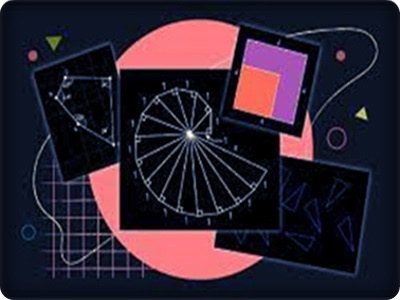Section 1: What is GeoGebra?
GeoGebra is an open-source software that was developed by Markus Hohenwarter in 2001. The term “GeoGebra” is a combination of two words: “geo” for geometry and “gebra” for algebra. It is designed to bridge the gap between these two disciplines and provide a platform for exploring their connections.
GeoGebra offers a range of mathematical tools, including dynamic geometry, algebra, calculus, spreadsheet, and graphing functionalities. It allows users to create, manipulate, and explore mathematical objects such as points, lines, angles, functions, and graphs. The software is available as a desktop application, web application, and mobile app, making it accessible to users across different devices.
Section 2: Features of GeoGebra
Interactive Geometry
One of the key features of GeoGebra is its interactive geometry capabilities. Users can construct and manipulate geometric objects such as points, lines, circles, polygons, and more. They can explore properties of these objects by dragging them, measuring distances and angles, and investigating relationships between different elements.
Algebraic Tools
GeoGebra also provides powerful algebraic tools that enable users to work with equations, expressions, and functions. It supports symbolic computation and allows users to solve equations, factorize expressions, simplify algebraic expressions, and perform various arithmetic operations.
Calculus Tools
For advanced mathematics learners, GeoGebra offers calculus tools that facilitate the exploration of concepts such as limits, derivatives, integrals, and differential equations. Users can visualize functions and their derivatives or integrals, investigate rates of change, and analyze the behaviour of mathematical models.
Spreadsheet Functionality
GeoGebra incorporates spreadsheet functionality that enables users to organize and analyze data. They can create tables, enter data values, perform calculations using built-in functions or user-defined formulas, and generate graphs based on the data.
Graphing Tools
Another notable feature of GeoGebra is its graphing capabilities. Users can plot functions, parametric equations, inequalities, and conic sections on Cartesian or polar coordinate systems. They can customize the appearance of graphs by adjusting colours, line styles, and adding labels or annotations.
Section 3: Benefits of GeoGebra in Education
Enhancing Understanding
GeoGebra promotes a deeper understanding of mathematical concepts by providing a visual representation of abstract ideas. Students can visualize geometric constructions, explore patterns and relationships, and make connections between different mathematical representations. This hands-on approach engages learners and helps them grasp difficult concepts more effectively.
Encouraging Active Learning
With its interactive nature, GeoGebra encourages active learning in the classroom. Students can actively participate in constructing mathematical models, manipulating objects, and investigating properties. This promotes critical thinking skills, problem-solving abilities, and collaborative learning.
Bridging Theory and Practice
GeoGebra enables students to bridge the gap between theoretical knowledge and practical application. They can experiment with mathematical models, test hypotheses, and validate their findings through visualizations and dynamic simulations. This helps them see the relevance of mathematics in real-life situations.
Differentiated Instruction
GeoGebra supports differentiated instruction by allowing teachers to adapt learning materials to meet the diverse needs of students. Educators can create interactive worksheets or activities with varying levels of difficulty or scaffolded instructions. This helps cater to individual learning styles and challenge students at their own pace.
Promoting Technology Integration
Incorporating GeoGebra into the classroom promotes technology integration in education. Students become familiar with using digital tools for mathematical exploration and problem-solving. They develop digital literacy skills that are essential for their future academic and professional pursuits.
Section 4: Applications of GeoGebra
Mathematics Education
GeoGebra has become a valuable tool in mathematics education at all levels - from primary school to university. It supports the teaching and learning of various topics such as geometry, algebra, calculus, statistics, probability, and more. Educators can create interactive lessons or assignments, demonstrate mathematical concepts, or provide virtual manipulatives for students to explore.
Science Education
GeoGebra is not only limited to mathematics but also finds applications in science education. It can be used to visualize scientific phenomena, create simulations or models for physics experiments, analyze data in chemistry experiments, or explore mathematical concepts in biology. The software allows students to engage with scientific concepts in an interactive and dynamic manner.
Research in Mathematics
GeoGebra has also gained popularity among researchers in the field of mathematics. Its computational capabilities support mathematical exploration and experimentation. Researchers can use the software to analyze data sets, test conjectures or hypotheses, create visualizations for presentations or publications, and collaborate with other researchers.
Section 5: Getting Started with GeoGebra
To get started with GeoGebra you can visit the official websitewww.geebra.org) and download the software for your preferred platform There are also online tutorials and resources available that provide step-by guidance using GeoGebra’s various features.
Once you have GeoGebra, you can begin exploring its different tools by creating geometric, solving equations inequalities, graphing functions or parametric equations, or analyzing data using spreadsheets. The software offers a user-friendly interface with intuitive menus and icons that make it easy to navigate.
In addition to the desktop application, you can also access GeoGebra through its web application or mobile app. This allows for seamless integration across different devices and enhances accessibility for both students and educators.
GeoGebra supports a wide range of mathematical topics, including:
- Geometry: Users can construct and explore various geometric figures, measure lengths and angles, perform transformations, and investigate geometric properties and theorems.
- Algebra: Users can solve equations, simplify expressions, factor polynomials, work with matrices and vectors, perform operations on functions, and more.
- Calculus: GeoGebra provides tools for differentiation, integration, and numerical methods, allowing users to study concepts like limits, derivatives, and definite integrals.
- Statistics: Users can create statistical diagrams, calculate basic statistical measures, and perform regression analysis to analyze and interpret data.
Conclusion
GeoGebra is a powerful tool that revolutionizes mathematics education by providing an interactive platform for exploration and discovery. Its combination of geometry, algebra, calculus, spreadsheet functionality, and graphing tools makes it a versatile software for teaching and learning various mathematical concepts. By leveraging GeoGebra’s features and benefits, educators can engage students in active learning experiences that promote deeper understanding and critical thinking skills. Whether in the classroom or for individual study, GeoGebra empowers learners to unlock the beauty of mathematics and science.
- The name "GeoGebra" is derived from the combination of "Geo" for geometry and "Gebra" for algebra. The software was developed by Markus Hohenwarter in 2001 as part of his master's thesis at the University of Salzburg, Austria. Since then, it has gained popularity worldwide and is used in schools, universities, and by individuals interested in mathematics.
- GeoGebra offers several interconnected tools within a single interface, allowing users to construct and manipulate mathematical objects such as points, lines, polygons, graphs, and functions. It supports both two-dimensional (2D) and three-dimensional (3D) representations, enabling users to visualize mathematical concepts in different dimensions.
- The software integrates dynamic geometry, algebraic calculations, and calculus computations, enabling users to explore and analyze mathematical relationships. For example, you can construct a geometric figure and simultaneously observe how its properties change as you drag points or alter parameters. Additionally, you can define and manipulate algebraic expressions and equations, plot graphs, and perform calculations involving derivatives, integrals, and more.
- GeoGebra also supports scripting and programming features, allowing users to create interactive mathematical applications and animations. It provides a platform for educators to develop customized teaching materials and interactive demonstrations to enhance students' understanding of mathematical concepts.
- The software is available as a free, open-source application and is compatible with various operating systems, including Windows, macOS, Linux, and also has web and mobile versions. The GeoGebra community actively contributes to its development, creating and sharing a vast collection of educational resources, including pre-built applets, worksheets, and tutorials.
- In summary, GeoGebra is a versatile mathematics software that integrates geometry, algebra, and calculus in an interactive environment. It facilitates mathematical exploration, visualization, and learning, making it a valuable tool for students, teachers, and mathematics enthusiasts.
- GeoGebra is a dynamic mathematics software that allows users to explore, visualize, and interact with mathematical concepts and objects. The name "GeoGebra" is derived from the Greek words "geo" meaning "geometry" and "gebra" meaning "algebra." It was developed to bridge the gap between geometric and algebraic representations, providing a comprehensive tool for learning and teaching mathematics.
- GeoGebra combines various mathematical areas such as geometry, algebra, calculus, and statistics into a single platform, making it a versatile tool for students, teachers, and researchers. It offers an intuitive interface where users can create, manipulate, and analyze mathematical objects such as points, lines, vectors, functions, graphs, and more.
- The software provides a dynamic environment where changes made to one object automatically update related objects, allowing users to observe and understand the relationships between mathematical entities. This interactivity enhances the learning process and enables users to explore mathematical concepts in a visual and hands-on manner.



